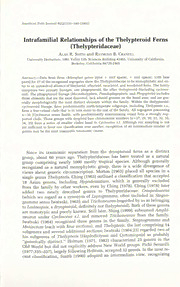
Intrafamilial Relationships of the Thelypteroid Ferns (Thelypteridaceae) PDF
Preview Intrafamilial Relationships of the Thelypteroid Ferns (Thelypteridaceae)
American Fern Journal 92(2):131-149 (2002) Intrafamilial Relationships of the Thelypteroid Ferns (Thelypteridaceae) Alan and Raymond Smith Cranfill R. B. University Herbarium, 1001 Valley Life Sciences Building #2465, University of California, 94720-2465 Berkeley, California — + Abstract. Data from three chloroplast genes [rps4 + trnS spacer, trnL spacer; 1350 base show Thelypteridaceae be monophylelic and pairs) for 27 of the recognized segregates the to sis- The an unresolved alliance of blechnoid, athyrioid, onocleoid, and woodsioid ferns. family ter to comprises two primary lineages, one phegopteroid, the other thelypteroid (including cyclosor- The phegopteroid lineage [Macrotbelypteris, Pseudophegopteris, and Phegopteris] includes oid). those elements that are the most dissected, lack adaxial grooves on the frond axes, and are gen- Within most elements within the family. the thelypteroid- morphologically the distinct erally predominantly north-temperate subgroups, including Thelypteris cyclosoroid lineage, three s.s., form free-veined clade that in turn sister to the rest of the family. All segregates possessing a is with predominantly anastomosing veins) form a strongly sup- = 36 (Cyclosorus sensu Smith, = chromosome numbers ported Those groups with dysploid base [x 27, 29, 30, 31, 32, 33, clade. Cyclosorus Although our sampling not 34, 35) form a series of smaller clades basal to s.I. is number one over another, recognition of an intermediate of yet sufficient to favor classification genera may be the most reasonable taxonomic course. from the dryopteroid ferns as a distinct Since taxonomic separation its Thelypteridaceae has been treated as a natural group, about 60 years ago, Although generally 1000 mostly tropical species. group comprising nearly wide divergence of monophyletic group, there a is recognized as a natural Morton placed species in a views about generic circumscription. (1963) all accepted Ching outlined a classification that single genus Thelypteris. (1963] which excluded Hypodematium, generally is 18 Asian genera, including Ching even by Ching (1978). (1978) later from the family by other workers, Craspedosorus Thelypteridaceae: genera added two newly described to included Stegno- synonym often in by us belonging gramma and Trichoneuron (regarded as sensu Iwatsuki, 1963); Both these genera of not thelypteroid). dryopteroid, definitely to Lastreopsis, a subsumed Amphi- Shing known. (1999), monotypic and poorly Still later, are from removed Trichoneuron the family. and neuron under Cyclosorus s.I. Stegnogramma and genera in the family, recognized three Iwatsuki (1964) comprismg 14 and Thelypteris, the last Meniscium with four sections), (each two regarded of Iwatsuki (1964:23) subgenera and additional sections; several probably and Cyrtomiopsis) as [Haplodictymm subgenera Thelypteris his of m genera the 25 characterized Holttum (1971, 1982) "generically distinct." New Sermolli World groups. Pichi address Old World but did not explicitly most genera. In the re- accepted 32 Holttum. following (1977:335-337), largely recognizing view, an intermediate adopted Smith cent (1990) classification.
